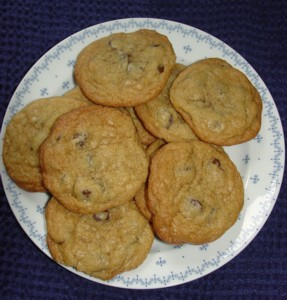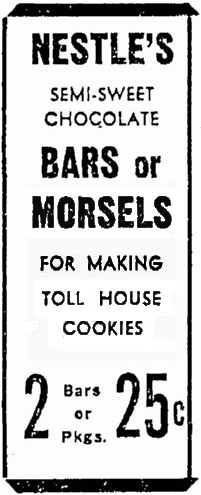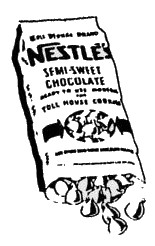

Chocolate Chip Cookies
Chip versus Morsel
A New England Invention - America’s Favorite Cookie
Tea Biscuit
The earliest I found the name “Chocolate Chip” to show up was in the late 1800’s in reference to a small English style tea biscuit. Tea biscuits are similar to our cookies.
1894
[Recipe] No. 557. Chocolate Chips. 15 c[ents]
This was a recipe for a small sweet biscuit that was cooked in narrow pans, spread thin, cut into inch strips and served with afternoon tea. It used melted chocolate. The “chip” aspect came from the small squares the biscuit was cut up into. The recipe was in the 1894 The Little Epicure: 700 Choice Recipes (page 208) published in New York.
Cream: ¼ cup butter, 1 cup sugar
Add: 2 Tablespoons melted chocolate, 1 teaspoon vanilla
Mix: 1 cup flour
Pour into greased pans and bake
1899
The Hostess of To-day by Linda Hull Lurned published a very similar recipe to the Little Epicure. It followed the same format: each recipe was numbered, named and its cost to the housekeeper was included “No. 674 Chocolate Chips 20 cts [cents]”. In the five years between 1894 and 1899 the cost to make the tea biscuit rose by 5 cents.
Candy
Candy was the next type of chocolate sweet to acquire the name “Chocolate Chip.” Candy with that name started to show up in the 1890’s.
1892
In the Pittsburg Dispatch (Pennsylvania) (December 18, 1892) Kaufmanns advertised “Our new Candy Department” in which they were the “Sole Pittsburg Agents for Whitman’s Chocolate”. In their advertisement they listed “Chocolate Chips”.
1893
In Lewiston, Maine another store, Grants Candy Emporium advertised Chocolate Chip candies. Lewiston Daily Sun (December 23, 1893) “Our line of 30 cent Chocolates is the finest in the city. A few of the many kinds: Chocolate Nougatines, Chocolate Walnuts, Chocolate Chips, Chocolate Colored Pepps, … This line of goods cannot be found anywhere else in the city.”
1897
A Supreme Court case “White et al. v. Trowbridge” had to determine the rights of a trademarked name ‘Trowbridge Chocolate Chips”. The product was “thin oblong pieces of molasses candy coated with chocolate and generally known as ‘chocolate chips’.” Trowbridge manufactured its Chocolate Chips candy in Meadville, Pennsylvania.
1902
Mrs. Rorer’s New Cook Book published in Philadelphia, Pennsylvania in 1902 listed the earliest known homemade Chocolate Chip Candy recipe. It consisted of 1 pound sugar, 1 cup water, and 1 saltspoon of cream of tartar. A simple sugar candy that was rolled flat, cut into strips and dipped into melted chocolate.
1906
The International Library of Technology listed Chocolate Chips “nobody sells this favorite candy for as little as 39c. [cents] except this famous candy store. It is a thin and crisp molasses chip, finely flavored with lemon and covered with a smooth and pure chocolate” The quote comes from an encyclopedia that was giving examples of how to market and advertise your product. It uses as its example a type of chocolate chip candy being sold at the time.
(Vol. 60, section 5, page 11)
1910
The Boston Cooking School Magazine published a Chocolate Chips candy recipe. The candy was made with corn syrup and coated with melted ‘Dot’ chocolate.
Recipe:
Bring to a boil, continue until it reaches 254 degrees, or between a soft and hard ball
½ cup sugar
¾ cup glucose or corn syrup
½ cup water
Add:
1 teaspoon vanilla
Turn out on to marble and shape into rectangle, score in strips one inch wide, cool
Cut into ½ inch long pieces and when cold dip in melted chocolate
‘Dot’ Chocolate
Vol. 14, No. 10, (May 1910) [page 495]
1918
The Economic Cookery published in Boston had a Chocolate Chip candy recipe made with brown sugar and molasses, a taffy type candy that was coated with melted chocolate and cut into 1” wide by ½” long. [Page 277]
Candy both sugar and molasses that were cut into small strips like chips, and dipped in melted chocolate became popular and were sold as “Chocolate Chips”. The candies originally were commercially made and later came recipes for homemade versions. The commercial candies were so popular the International Library of Technology in 1906 gave directions to stores selling Chocolate Chip Candies on ways to advertise to the best advantage. The small size and the chocolate coating combined to give the candy its common name.
Cookies
The English style tea biscuit was the first to be called “Chocolate Chip”. The tea biscuit although a small thin cookie used melted chocolate. This was followed by candies that also used the term “Chocolate Chip”. The candies like the tea biscuits used melted chocolate. It was not until the late 1930’s that “Chocolate Chip” was used in the name of a cookie recipe. Chocolate Chip Cookies refer to cookies with small chunks of chocolate that remain whole during the baking process.
1930’s
The Original Chocolate Chip Cookie – Toll House Chocolate Crunch Cookies
Sometime prior to 1936 Ruth Wakefield created a cookie with chocolate chips. She listed the recipe in her 1936 cookbook, Toll House Tried and True Recipes under the name “Toll House Chocolate Crunch Cookies.” (Wikipedia – “Chocolate Chip Cookie” entry). The couple owned a former Toll House which they converted into an inn and restaurant. One source says Ruth Wakefield’s recipe was published in a Boston newspaper and other papers in New England (ideafinder.com/history/inventions/tollhouse). Newspapers were a common way to publish a new recipe. It is likely she did publish her recipe in a newspaper(s) but without specific names and dates this can not be verified.
In 1939 the Wakefield’s formed an agreement with the owners of Nestle chocolates whereby Ruth’s recipe was published on 7 oz. bars of Nestle’s semi-sweet chocolate with the yellow wrapper. Nestle’s shortened the name to “Toll House Cookies”. At first, the company developed a cutter to break the bars of chocolate up into small pieces. The morsels came later.
Chocolate Chips and Chocolate Chip Cookies
1938 - 1941
The previous year, in July 1938 the Chicago Tribune carried a recipe named “Chocolate Chip Cookies”. In the Youngstown Vindicator (Nov. 26, 1939) the newspaper carried an article “Make Up Your Christmas Cookies Early, Too” by Mrs. Alexander George. The recipe “Chocolate Chip Cookies” listed 8 squares dipping chocolate cut in quarter-inch cubes. In the Montreal Gazette (Nov. 28, 1940) carried an article “Keep Cookie Jar Full Is Rule for Good Cook”. This “Chocolate Chip Cookies” recipe listed 1 package semi-sweet chocolate “cut each small square of chocolate in 4 to 6 pieces.” In these two recipes squares of chocolate were cut into small pieces.
The Pittsburgh Press (March 26, 1940) ran an advertisement, “How to Make Famous Toll House Cookies. From the famous Toll House Inn at Whitman, Massachusetts, comes this recipe for cookies that are taking the country by storm.” Under the recipe it states, “Insist on Nestle’s Semi-Sweet Chocolate in the Yellow Wrap,”. The yellow wrapper was used on 7 oz. bars. The statement, “Insist on Nestle’s …” indicates other companies were producing semi-sweet chocolate squares or bars at the same time.
 From April 1940 through October 1940 Nestle ran a series of advertisements in national newspapers with the recipe for Toll House Cookies. The advertisements vary in wording but follow a similar basic text. All have a recipe that calls for cutting the nestle bars into “pea size” bits. The first advertisement for Nestle morsels appears in the Springfield Republican on December 6, 1940 (shown on the right). The ad is for both the bars and morsels. It lacks the illustration of the morsels that appears in 1941 advertisements. The end of the ad campaign for the bars on October and the appearance of an ad for both bars and morsels in December suggests that morsels first came to market in either November or the first week of December 1940. It was probably timed to take advantage of the holiday season.
From April 1940 through October 1940 Nestle ran a series of advertisements in national newspapers with the recipe for Toll House Cookies. The advertisements vary in wording but follow a similar basic text. All have a recipe that calls for cutting the nestle bars into “pea size” bits. The first advertisement for Nestle morsels appears in the Springfield Republican on December 6, 1940 (shown on the right). The ad is for both the bars and morsels. It lacks the illustration of the morsels that appears in 1941 advertisements. The end of the ad campaign for the bars on October and the appearance of an ad for both bars and morsels in December suggests that morsels first came to market in either November or the first week of December 1940. It was probably timed to take advantage of the holiday season.
The earliest reference to the term “chocolate chips” as the name of a precut piece of chocolate appeared in the Pittsburgh Press on April 18, 1941. The newspaper printed a recipe for “Chocolate Chip Squares are Tops”. The recipe listed “one 7-oz. package semi-sweet chocolate chips”.
How a Recipe Swept the Nation by Storm?
Between 1938 and 1941 the recipe that was created in Whitman, Massachusetts traveled across the United States and into Canada. It showed up in newspapers in the following cities: Chicago, IL, New York, NY, Los Angeles, CA, San Jose, CA, Milwaukee, WI, Hartford, CT, Phoenix, AZ, Youngstown, PA, Pittsburg, PA, Lewiston, ME (?), Sarasota, FL, Fort Dearborn, MI, and Montreal, Canada. By May 1940 an article in the Chicago Tribune had this to say, “will share honors with the famous chocolate chip cookies that are such a universal favorite today.”
How a recipe becomes known as an old fashion tradition?
In May 1941 the New York Times carried an article that said, “Chocolate chip cookies are an old fashioned New England [tradition] that has only recently been discovered by city dwellers.” The cookie was about 6 or 7 years old.
Oddly, the famous Boston Cooking School Cook Book did not publish the recipe until its 1947 edition under the name “Chocolate Chip Cookies”. The recipe was an exact match to Ruth Wakefield’s famous “Toll House Chocolate Crunch Cookies” except that it reduced the ingredients by half. In 1939, Nestle chocolates had acquired the exclusive right to the name “Toll House Cookies”. This forced Fannie Farmer, author of the Boston Cooking School Cook Book to use the common name, “Chocolate Chip Cookies”.
This cookie has two common names: “Chocolate Chip Cookies” and “Toll House Cookies”.
Chocolate Chip Cookies
1/2 cup butter, softened
1/3 cup white sugar
1/3 cup brown sugar
1 egg, beaten
½ teaspoon vanilla
1 1/8 cups flour
½ teaspoon salt
1 teaspoon baking powder
½ cup chopped nuts
1 cup semi-sweet chocolate chips
A 1941 Illustration of the Nestle Morsels from a newspaper advertisement.

MORE INFORMATION AVAILABLE ON “TOLL HOUSE COOKIES” WEBPAGE
